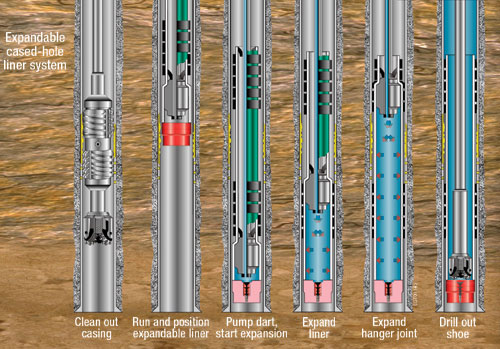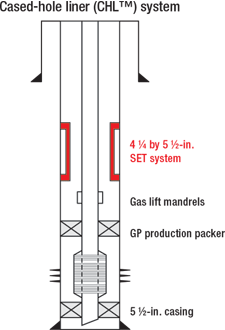Petroleum Technology Digest: Solid expandable casing liner salvages inland water completion
Solid expandable casing liner salvages inland water completionA workover solution featuring a cased-hole liner, in tandem with a specially designed packer, salvaged a South Louisiana, inland water oil completion and paid for itself in under five months.TOCE Oil Co. (TOCE) salvaged a Louisiana inland water completion by using a 1,560-ft, cased-hole liner (CHL*) installed by Enventure Global Technology inside 5-1/2-in., 17-lb. casing. Data from caliper logs were essential in determining the length and location of the required CHL system. Prior attempts to regain casing integrity using conventional cement squeeze operations had been unsuccessful. The new completion provided sufficient clearance for a specialty packer, which was set below the cased-hole liner. The workover solution paid for itself in about 4-1/2 months (based on $30/bbl oil), and production has averaged about 100 bopd since the August 2003 completion. BACKGROUND TOCE’s LL&E A-1, an inland water location in southern Louisiana, was originally drilled in 1986 and completed in the Lower 96 sand at about 10,000 ft. It produced 200 to 300 bopd from initial completion until the mid-1990s, when casing integrity problems became evident from sand and shale production. Pending remedial operations, the well was shut-in for about a year. The LL&E A-1 completion is a low-pressure oil zone that eventually required artificial lift. In this case, the well produced enough natural gas to supply not only the gas needed for gas lift operations, but also enough gas to sell to a nearby pipeline for compressor operations. Beyond the need for casing integrity to provide zonal isolation and environmental concerns, gas lift operations require reliable, complete casing integrity. Since there is only one pay zone in this well, the choice for TOCE was either to work over the well to regain casing integrity, or plug and abandon the well. Before considering the Solid Expandable Tubular (SET*) Technology, the operator attempted to regain casing integrity using conventional cement squeeze technology. During a 10-year period, four different cement squeeze operations were performed in the 3,100-to-4,800-ft range with mixed results. Despite these operations, casing integrity was problematic. When a negative differential was placed on the casing, the squeeze would fail. After evaluating thinner-wall casing patches, TOCE turned to the CHL solution. The CHL systems are composed of API-sized casing, whose mechanical properties have been modified for use in an expandables environment. The liners are run into the wellbore like conventional casing, then expanded in situ with a hydraulically driven expansion cone, Fig. 1. After the expansion cone increases the pass-through diameter, it produces a robust, high-pressure (about 10,000 psi) elastomeric seal against the previous casing string. Additional seals can be placed along the string, as dictated by the application, to isolate numerous casing defects or perforated zones.
JOB DESIGN Knowing that the cased-hole system would place a slight restriction in the wellbore’s upper section, the operator conducted a comprehensive evaluation of the completion. After much planning, an inflatable packer was selected for the initial completion, but was later replaced with a specially designed, high-clearance GPpacker. This completion included a set of gas lift mandrels and associated landing profiles for flow control purposes. Early discussions focused on using a CHL system that was approximately 200 ft in length. Further pre-job discussions led to the decision to run a high-quality casing inspection log to determine if there were other areas of the wellbore that had external corrosion, wall loss or pitting. This caliper run and additional planning proved to be beneficial, as it was determined that the damaged casing interval was longer than anticipated. After reviewing the caliper log, a 1,600-ft CHL system was ordered to the location. JOB EXECUTION Prior to expansion, the CHL system had a 4-1/4-in. OD. The system was run to desired depth; pressure was applied below the expansion cone, and expansion was initiated. During this part of the installation, a sealing anchor hanger was expanded into the interior surface of the 5-1/2-in. casing. The process is depicted in Fig. 1. Ample length of the system was run above and below the damaged casing, as TOCE wanted to ensure complete sealing and re-lining of the well along the section with suspected casing integrity problems. After the system was run and expanded, a pressure test, which exceeded the pressure required for gas lift operations, was performed on the re-lined wellbore. The entire installation process, from crew callout to pressure testing, took only two days, and was executed safely and without impact on the environment.
After a successful pressure test, TOCE initiated the final stages of the well’s completion. An inflatable packer was the operator’s first choice to provide a pressure barrier between the completion interval and production casing. This completion plan was initially run to start production. After only two weeks, the inflatable packer failed. A workover rig was moved back on location. After unsuccessful attempts to pull the packer, which could not be pulled through the liner restriction, the packer was pushed below the perforations. A specialty packer, designed by Packers and Service Tools, was run through the slight restriction of the CHL system to a depth of 9,907 ft, Fig. 2. Gas lift mandrels were run in the production tubing to facilitate lifting fluids to the surface. ECONOMICS Total job cost, from the caliper log through installation of the permanent completion equipment, was $397,000. This figure includes $44,000 for a new tubing string. The expandable CHL system installation, Table 1, represents about 27% of the total workover expenditure.
Although project payout occurred in about 4-1/2 months, the most important aspect of this completion was that a P&A candidate was salvaged. Since the installation of the expandable cased-hole liner in August 2003, production has averaged roughly 100 bopd. LESSONS LEARNED Operators’ usage of SET* Technology has proven that it is a viable solution to well completion challenges. TOCE committed considerable resources to conventional squeeze technology before considering the expandable liner. When developing CHL system workover plans, operators must keep the well’s completion objectives in mind. Experience in this field shows that the use of inflatable packers below the liner is not a viable option. The service life of these packers is not compatible with production objectives, and when they do fail, they cannot be pulled through the slight restriction in the expandable liner. The GP packer designed by Packer and Service Tools worked well in this gas lift, low-pressure, oil sand application. TOCE’s allocation of resources to evaluate the quality of the entire casing string by running inspection/ caliper logs cannot be over-emphasized. The installation’s financial success was due largely to the fact that the casing integrity issue was addressed prior to determining the length of the CHL system. The two-day installation, which was conducted safely and expediently, was a factor in reducing the workover cost.
|
|||||||||||||||||||||||||||||||||||||||||||||||||||||||
- Coiled tubing drilling’s role in the energy transition (March 2024)
- Shale technology: Bayesian variable pressure decline-curve analysis for shale gas wells (March 2024)
- Using data to create new completion efficiencies (February 2024)
- Digital tool kit enhances real-time decision-making to improve drilling efficiency and performance (February 2024)
- E&P outside the U.S. maintains a disciplined pace (February 2024)
- Prices and governmental policies combine to stymie Canadian upstream growth (February 2024)
- Applying ultra-deep LWD resistivity technology successfully in a SAGD operation (May 2019)
- Adoption of wireless intelligent completions advances (May 2019)
- Majors double down as takeaway crunch eases (April 2019)
- What’s new in well logging and formation evaluation (April 2019)
- Qualification of a 20,000-psi subsea BOP: A collaborative approach (February 2019)
- ConocoPhillips’ Greg Leveille sees rapid trajectory of technical advancement continuing (February 2019)






